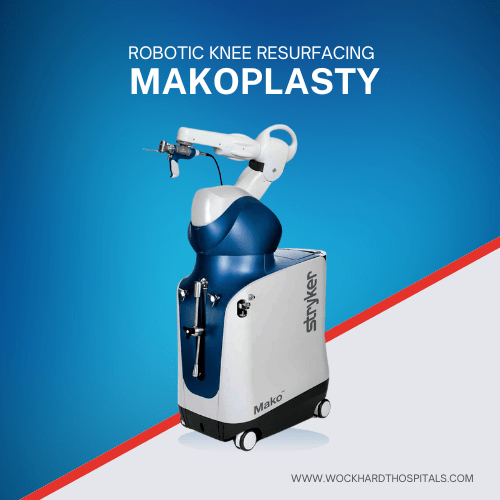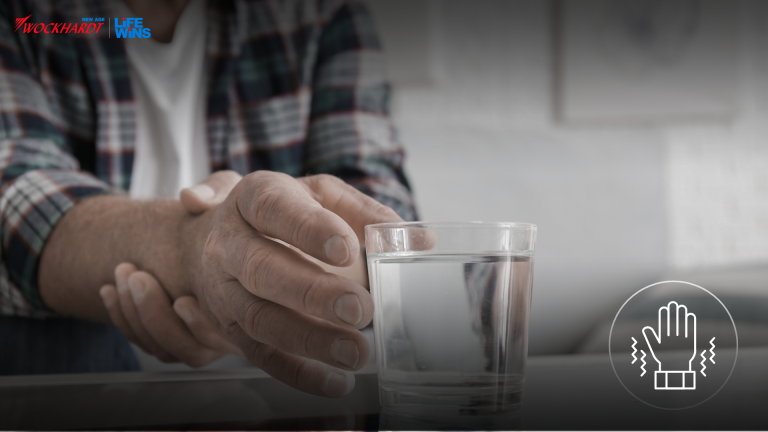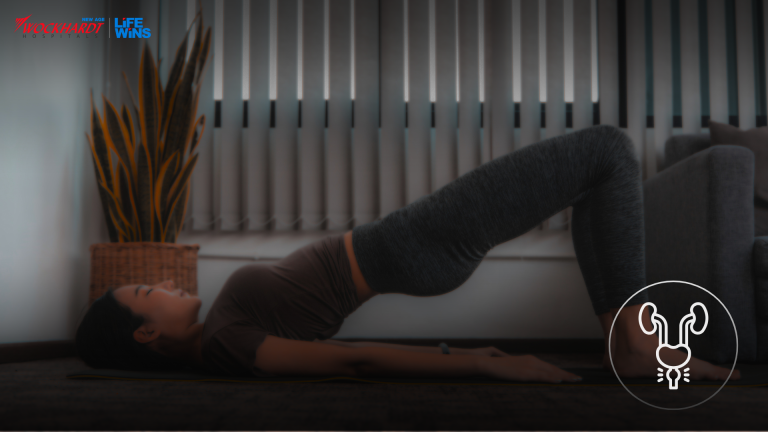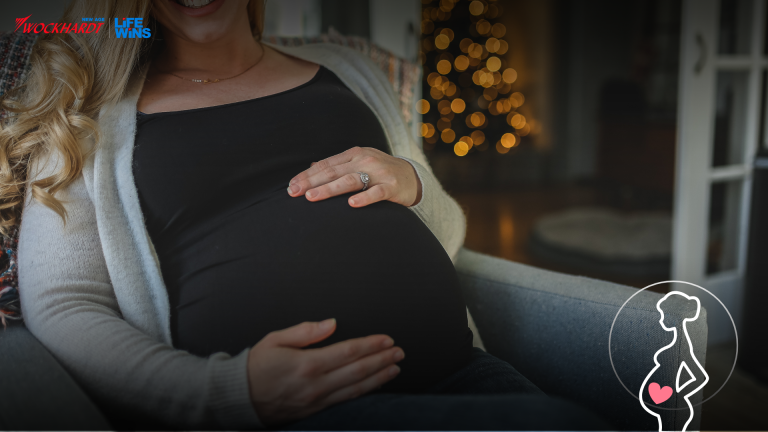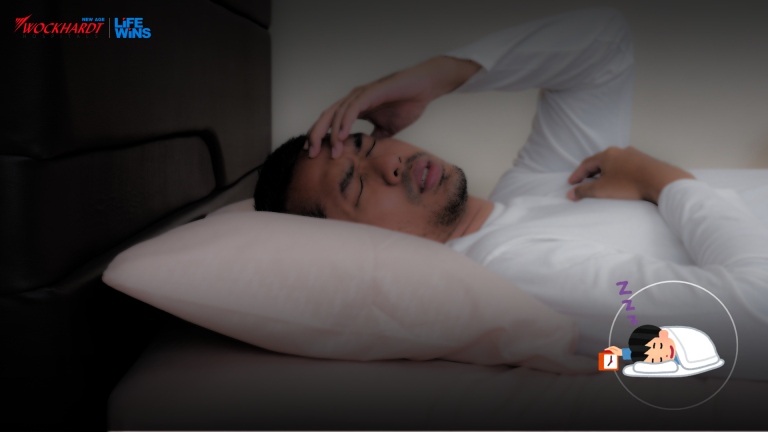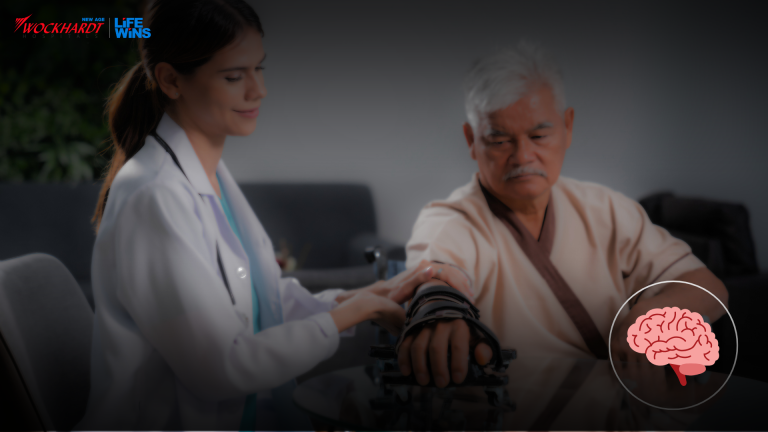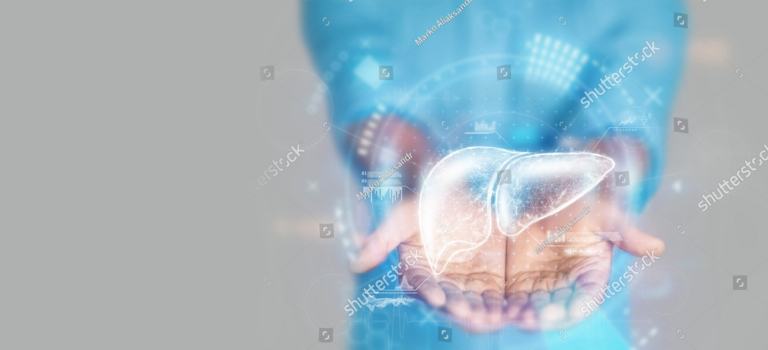Gall Bladder Infection with Rupture, Induced Multiorgan Failure and cardiac arrest, In 56-Year-Old Man Successfully Operated At Wockhardt Hospitals, Mira Road

A team headed by Dr Imran Shaikh, Consultant GI & HPB surgeon, Wockhardt Hospitals, Mira Road, saved the life of a 56-year-old man with an infection and ruptured gall bladder that led to multiorgan failure. The patient was very critical with lifesaving supports for heart and lung, underwent major life-saving surgery – Exploratory laparotomy with cholecystectomy and peritoneal lavage with drainage. The patient is discharged after 15 days and he is now resumed back his work. Mr Prakash Acharya, a 56-year-old resident Bhayandar, who is working as supervisor encountered severe excruciating abdominal pain and Vomiting. He experienced this kind of pain the first time. The pain was so severe that he needed injections and also, he couldn’t eat food. Though, he didn’t have other comorbidities such as diabetes and hypertension. He was admitted to a nearby nursing home and on evaluation found to have Gall bladder stone with severe infection and complication like rupture of Gall bladder. There was a severe infection along with multiorgan failure that took a toll on his kidneys, lungs, and heart. He was critical and planed Gall bladder surgery at a nursing home. To the patient’s dismay, after anaesthesia, he suffered from cardiac arrest and was given Cardiopulmonary resuscitation (CPR), a life-saving technique to revive him. After two attempts of CPR, he was revived and surgery was deferred. He was put on a ventilator and shifted for further management at Wockhardt Hospitals, Mira Road. Dr Imran Shaikh, Consultant GI & HPB Surgeon, Wockhardt Hospitals, Mira Road highlighted, “Patient arrived in very bad shape. In the emergency room, the patient was unstable with on high ventilatory and cardiac support. The patient was shifted to ICU on life-saving support. The condition was so critical that despite maximum ventilatory support his oxygen saturation would remain around 88 %. He required three lifesaving drugs in very high dosages to barely maintain his heart and Blood pressure. His kidney was hit badly with high creatinine and low urine output. Emergency CT scan of chest and abdomen done which showed worsening infection in the abdomen as well as in chest. Patients vigorous resuscitation continued in ICU as per standard protocol. Higher antibiotics, nutritional support, ventilatory and BP support and Kidney supports were continued. A most important decision was to operate upon him which was supra major surgery and considering the critical status of the patient it would have been a very high risk to his life. We waited almost 24 hours and continued resuscitation before we could make him little better to subject for surgery. Team of doctors including Intensivist, Physician, Chest Physician, Cardiologist and Gastrosurgery tried very hard to make him stable so that surgery can be performed. Surgery was lasted for four hours & Patient tolerated surgery very well. During surgery lot of pus and infection drained from the abdomen and Gall bladder was removed. The whole abdomen was thoroughly cleaned. He was shifted to ICU on all lifesaving support. As soon surgery controlled the source of infection, he showed remarkable recovery in ICU. Within 72 hours his heart and BP stabilised and kidneys improved. Though he required a ventilator for 5 days but made an uneventful recovery. After 7 days of surgery, he was shifted towards on full diet. While recovering in the remains drowsy Inspite all other organs were improving, so neurologist opinion was sought. Biggest fear was hypoxic brain injury which happens due to lack of blood supply to the brain when the heart was stopped twice. But fortunately, no major injury to brain detected and he improved on medical management. After two weeks from surgery, he was all fit and discharged. A lot of people take Gall bladder stone very lightly, but it has associated with a complication like acute infection, Jaundice, perforation, gangrene and Cancer. All these complications are life-threatening. We can avoid this complication by simple Laparoscopic surgery in an elective setting which requires an only one-day hospital stay. Also, whenever complication happens it should be managed at the tertiary care centre where all facilities and experts are available. We could save this patients life purely because of teamwork and facilities. “My abdominal pain was unbearable to the extent that I couldn’t even move or walk properly. My world came crashing down after I got to know that the gallbladder has ruptured. I was hoping for some miracle to happen and was happy to know that the doctors gave me a fresh lease of life. I thank the doctors for their limitless efforts taken amid the pandemic. Now, I can do my daily chores with ease and have resumed to normal life,” concluded patient Mr Prakash Acharya. Source: http://mediabulletins.com/health/gall-bladder-infection-with-rupture-induced-multiorgan-failure-and-cardiac-arrest-in-56-year-old-man-successfully-operated-at-wockhardt-hospital-mira-road/
Love a good cuddle? Here are 7 legit reasons why you should get cozy more often

From a jadu ki jhappi to intimate cuddling — there’s just something about holding someone closely that’s oh-so-comforting! You might not be someone who loves cuddling, but trust us, the power of touch can’t be undermined at all! Even doctors believe that it not just promotes healing, but there are several other health benefits that you get when you cuddle. According to psychiatrist, Dr Rahul Khemani from Wockhardt Hospitals in Mumbai, touch is the first sensation we learn about. It develops way before we develop vision, or even learn to speak. Cuddling is also a form of communication. Skin-to-skin contact has been encouraged after child birth to strengthen the mother-child relationship. And the impression of this memory stays with us for the rest of our lives. “Hence, it isn’t surprising that cuddling, or physical contact with someone you love has an impact on your physical and mental well-being,” he says. 1. It releases love hormones When you cuddle, your body releases more oxytocin, or the ‘love hormone’. This doesn’t happen even when you do something that otherwise makes you happy, be it cooking, cleaning or listening to music, etc. 2. Cuddling builds better bonding “More oxytocin in your body means more bonding. And by bonding, I mean being in sync with the other person emotionally,” says Dr Khemani. 3. Cuddling keeps you calm When someone hugs, you instantly feel a sense of calm. That’s because cuddling or hugging lowers stress by releasing oxytocin, which is a natural anti-anxiety medication. “It also gives us a break from our otherwise hectic and busy schedules. Touch soothes us, makes us feel safe and secure. It makes us feel loved and comforted,” he suggests. 4. It reduces stress “When your stress levels are lower, you find it easy to sleep, and cuddling is a great way to do that. Your serotonin levels get a boost too, with cuddling. This in turn makes you feel good about yourself and can be immensely beneficial when you find yourself in a negative headspace,” he recommends. So, if you are having a real stressful day then just cuddle it away. 5. Cuddling build sexual intimacy Snuggling into each other’s arms and touching not just helps you bond with your partner, but it also restores that spark between you two that improves your sexual relationship, and makes you comfortable with intimacy. It’s like the first step towards getting physical. 6. Cuddling regulates heart rate “If you want good heart health, then you must cuddle. Also, when someone is angry or emotionally charged, then their heart rate shoots up. A cuddle can lower it down to an optimum level. “When you are in close contact with your partner, you unconsciously pick on their body rhythms. Cuddling can help you sync your partner’s breathing with yours, even when they start getting anxious or hyperventilating,” he explains. 7. It relieves pain Oxytocin also helps in soothing pain. That’s why touch therapy is recommended when you experience mental or physical discomfort. It makes you feel needed, and shows someone is there during your lows. This brings emotional satisfaction and a sense of comfort, due to which oxytocin is released in the body to ease out pain. The last word “We need to understand that little things like cuddling make a whole lot of difference. Touch is an integral part of the human experience, and will remain so throughout our lives. A lot of what we do is determined by the sensation of touch. With this pandemic and physical distancing, it has become even more important to gather those oxytocin molecules by cuddling with someone you love. And if you don’t have a person to cuddle with, get yourself a pet! Snuggling with a pet brings equal amounts of happiness,” he concludes. So when Sheldon from The Big Bang Theory can approve of cuddling — what’s the deal with you peeps? The moral of the story is: even if you hate being a snuggler, do it for the sake of your well-being! Source: https://www.healthshots.com/mind/happiness-hacks/here-are-the-7-surprising-health-benefits-of-cuddling/
Why crying might be good for your health, according to a top psychiatrist

From uplifting your mood to easing out pain, crying once in a blue moon can benefit you in many ways. Hear it from a psychiatrist. Have you ever come across this phrase: “No use crying over spilt milk”? But, the point is why not? What’s the harm in crying? Because we have got proof that if you’re feeling down and out, then crying can actually help you in so many ways! Stunned? Well, who wouldn’t be? But it’s a fact that crying helps you release a range of emotions, and that’s a good thing. According to experts, it is a natural human response to any emotion – that’s why we get happy tears too. According to Dr. Sonal Anand, a psychiatrist at Wockhardt Hospitals, Mumbai, it is also an evolution that plays its role. When a child cries, s/he cries for attention or help. Similarly, crying also becomes a non-verbal way to communicate to the other person that you’re seeking support. How does crying help you relax? Let’s hear it from an expert “When u are stressed, cortisol or ‘stress hormones’ are released in your body. This amps up your emotions, which trigger your tear ducts as well. When you are high on emotion, then along with your tears, protein and stress hormones are also released. This happens especially when you are angry or stressed.” She explained. She continues, “There is a release of leucine enkephalins which are nothing but endorphins. This helps in relieving pain and boosting your mood simultaneously. After that, your parasympathetic nervous system (PNS) takes over and signals the body that everything is fine, and makes you feel relaxed.” Crying also helps to restore your emotional balance Dr Anand explains that we don’t cry, when we are just sad. We also cry when we are way too happy or anxious. This majorly happens because we are all high on emotions. At that time, your body responds by crying, so that the tsunami of emotions can be controlled and restored back to normal. “A good crying session can actually make you feel lighter and better. It soothes your mind and that’s why most of us feel like sleeping after crying, because stressors are released from the body and your mind feels much calmer”, she said. She concluded, “But we need to watch out if you or anyone you know cries at the drop of a hat. This is because it can signal mental distress, and sometimes such cases need medical intervention because too much crying is alarming.” So, the next time someone calls you weak or judges you for crying – don’t pay heed to it, because it’s all for the sake of your own mental peace. Source: https://www.healthshots.com/mind/happiness-hacks/heres-why-a-good-cry-is-beneficial-for-you/
To The Manner Born – Gen Z Miqdad Khorakiwala on Stem Cell Therapy
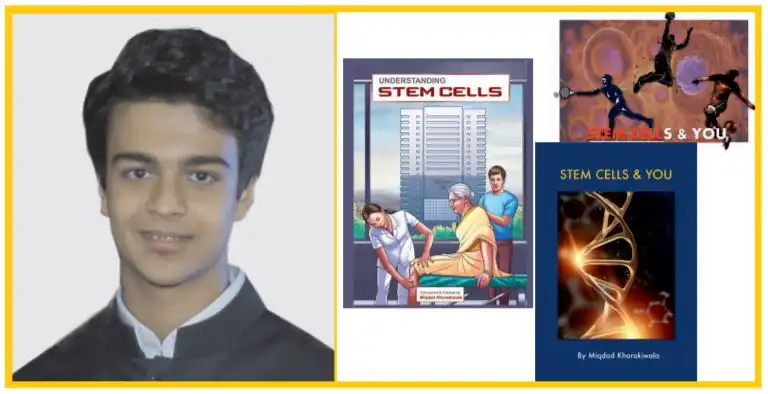
Miqdad Khorakiwala, the eldest son of Dr. Huzaifa Khorakiwala, after deep study and extensive research, conceived and wrote articles on ‘Stem Cells Passport’, ‘Stem cells & You’ and ‘Understanding Stem Cells’, which provided clear insight into what could be described as a revolutionary addition to medical advancement. The genesis of stem cell research began when the first successful transplant was carried out by Dr. Thomas of the Fred Hutchinson Cancer Research Centre for the treatment of Leukaemia. This continued progressing as a field of study until Hematopoietic cells were discovered in 1978 in human cord blood. In 1981, Martin Evans came across a certain type of cells in mice that we now call Embryonic Stem Cells. All of this research, when put together, helped aid scientists clone ‘Dolly’, the sheep who was the first artificial animal created. Quick progress was made within four years of cloning Dolly with the first-ever embryo being cloned at the early stage of 4-6 cells, in 2001. However, due to ethical issues cropping up, President George W. Bush banned government funding for the research until about 7 years later, under the Obama Administration, when clinical trials were allowed to resume. In 2010, a person with spinal injury became the first to receive such treatment derived from human embryonic stem cells as a part of the trials by Geron of Menlo Park. Adding to this, in 2012, the successful treatment of age-related macular degeneration and Stargardt’s macular dystrophy, where improvement in visual acuity, was noticed within two weeks post-procedure, helped build the ever-growing reputation of stem cell research. Described as non-specialized cells that are found within the human body, these specific cells carry the ability to grow and adapt to any other cell due to the two very unique properties it possesses: Self-renewal and Potency. Their distinguishing factor lies in the three main types of the latter property mentioned above. The first and foremost being Totipotent cells that boast the highest differentiation potential along with the capacity to grow into a completely new organism. Given the ease of isolating such cells and providing them with an environment conducive for growth, it can paint itself as one of the best examples to represent the vast advancements made in the this field. However, not everything can be picture perfect. A pitfall that many take issue over is the ethical dilemma behind sourcing such cells- usually gained from those of a zygote or a fertilised egg. Pluripotent cells, on the other hand, while relatively displaying less differential potential are also easy to isolate and grow, however, the obstacles that one could be presented with, move from ethical issues in relation to these cells taken from the layers of a human embryo as well as teratoma formation which are benign tumours that form from the growth or differentiation of such cells. As for Multipotent cells that are equally differentiable but are restricted to those within the same family, a viable example could include Hematopoietic cells/ Blood cells from bone marrow, with lesser ethical issues and lower immune rejection chances it could arise as one of the most accepted forms of stem cell therapy. However, such cells are immensely hard to isolate. Categorization of stem cells also depends upon its sources with Embryonic stem cells and Adult stem cells taking up the two main umbrella classifications. The former being cells that are separated from 2-11 days old human embryos, commonly known as blastocysts, and are known for having the highest potential to help regenerate and repair tissues and organs within the body. Bur as mentioned before, a common ground for concern pops up due to what it requires to isolate such cells: destruction of the embryo, which raises moral issues concerning the taking of a life. Secondly, the risk of tumorigenicity and teratoma formation, given how difficult it is to control the growth and differentiation, remains probable. Adult stem cells are mostly multipotent with a less differentiation capacity than embryonic stem cells, nonetheless, these cells are obtained from adult tissue like bone marrow, tooth, adipose tissues and are considered to be more ethical. They can also be further classified under Autologous transplants, which is when the patient is their own donor and Allogeneic Transplants where the cells come from another person. The therapy relies upon repair of damaged cells and replacement with new functional ones. Usually used for a variety of conditions ranging from spinal cord injuries to orthopaedic conditions, Parkinson’s, Alzheimer’s, Diabetes mellitus and many more. While not providing a cure, it can substantially increase the quality of life for the patients. The basic steps undertaken in stem cell therapy follow a 4 pointer programme: The challenges in this discipline usually prove to be a detriment to those perusing through their options with a few ranging from Manufacturing Issues, Culture conditions, Incorrectly differentiated cells, lack of proper delivery and skilled personnel, Ethical issues and financial limitations of those seeking practicable options, poor support and immunological rejection. Combatting the aforementioned points, stem cell therapy remains as a beacon of regenerative medicine designed to prove helpful for those suffering from severe injuries or chronic diseases. With unlimited power of self-renewal, multiplication and the ability to change into other types of cells, this form of therapy has dealt successfully with Leukaemia and Hematopoietic Disorders to Impairments of the Brain, Autism, Multiple Sclerosis and Cardiovascular Diseases. The general consensus regarding this streamlined topic borders on a lack of awareness; which was highlighted through the comic series ‘Understanding Stem Cells’ by walking the reader through the steps taken by Wockhardt Hospitals stem cell facility.
Ridden with Grief? A Psychiatrist Reveals How it Can Affect the Health

Our emotions aren’t futile. They have a huge impact on our overall well-being. One such emotion is grief. Grieving is always counted as a single unit, but it is multifaceted. It comes with pain – both physical and mental. That’s why it becomes all the more important to understand this emotion to tackle it better. One of the biggest reasons for grief is the loss of a near and dear one. Dr. Sonal Anand, a psychiatrist from Wockhardt Hospitals, Mumbai suggests that grief comes with a purpose i.e. to serve our emotional health, and is essential for us to adapt to our new life circumstances. “Grief is an important emotional and cultural aspect of human evolution. Unfortunately, in some cases, grieving can become prolonged and cause immense distress leading to pathological grief which is an altered mental state requiring treatment”, she says. Here are the five ways recommended by Dr. Anand, which explains how grief affects our body: 1. Grief Increases Stress Hormones Any kind of stress causes the release of cortisol, and the flight or fight response makes react in different ways — whether it is a faster heart beat, increase in blood pressure, dilatation of pupils, increased breathing, or certain endocrine changes. “The body can adapt to all these changes for a short while, but chronic exposure to such situations comes with its own set of problems. Chronic hyperdrive predisposes to the metabolic syndrome conditions like diabetes, hypertension, heart problems, mental disorders”, she says. 2. Grief Can Lead to Sleep Disorders, Body Ache, and Nagging Headaches Grieving way too much can numb the body, and give rise to sleeping problems. Stress hormones released in the body keeps it awake. The diurnal variation can become a problem too. “Some people have inverted sleep problems where they sleep in the day and remain awake at night. A few people may have hypersomnia, where they suffer from excess sleeping issues, which can last for a few days. This is a kind of defense mechanism to avoid dealing with the situation”, she explains. Dr Anand suggests that body aches are also seen in people, due to the constant release of cortisol. Muscle is also experienced by some people. “New-onset headaches can be seen or rise in frequency of migraines is also common”, she cautioned. 3. It Can Also Lead to Eating Disorders Grieving can alter your appetite to a large extent. Physical needs are left behind due to the trauma of grief. Loss of appetite, nausea, vomiting, diarrhea, and irritable bowels could be the changes seen in the gastrointestinal system. Some people could go through stress eating or binge eating and find comfort in eating. Weight loss or weight gain, nutritional deficiencies are the after-effects. 4. Grieving Can Decrease Immunity We all know how immunity has become a buzzword these days, but grief can make you compromise on that too. “Stress triggered by grief causes inflammation in the body and weakens the immune system. It also causes direct changes in the blood indices, which can lead to a weakened immune system. This predisposes to other infectious or worsens any ongoing inflammation”, she explains. 5. It also Impacts the Functioning of the Brain “Anxiety and panic are physical signs that you experience while grieving. There may be a complete denial of death initially, but as the grieving continues acceptance comes in gradually. Feeling sad comes in waves, and between these spurts, opportunities to be consoled are accepted. Some people feel a strong urge towards alcohol, smoking, or even drugs for relief. However one must realize that these high-risk behaviors are detrimental. Self-harm ideation can also become a coping mechanism”, she says. Not just that but she said that there is a sudden drop in the concentration levels of the person. Too many thoughts run in their head, flashes of old memories or traumatic events are seen over and over again. “Crying is a physical response, and can actually relieve the body of excess pressure. Having a few emotional changes are bound to happen during normal grieving. Help must be sought if grieving is leading to depression or too many physical problems, or the inability to cope”, she concludes. The bottom line is that even though grieving and crying your heart out can make you feel lighter and better if it is prolonged it can mess up with your head and health. So, watch out for all these signs and don’t get trapped.
COVID Warrior Travels From Vishakhapatnam To Mumbai

Chandini Mulukutla who works as Infection Prevention Control Nurse at Wockhardt Hospitals in Mumbai, traveled from Vishakhapatnam during lockdown to join COVID duty post her maternity leave. 33-year-old Chandini Mulukutla, Infection Prevention Control Nurse, was busy being a new mother when the outbreak of Coronavirus pandemic was reported in China on December 31, 2019. In March 2020, the pandemic was still at a nascent stage in India, and Ms Mulukutla along with her four-month-old baby and family went to her native place in Vishakhapatnam. Little did she knew that a nationwide lockdown will be imposed to contain the spread of the Coronavirus and she will not be able to return to Mumbai even after her maternity leave is over. But the desire to serve the nation and help fellow nurses and doctors to fight against COVID-19 pushed her to cross the borders and resume her duty. Recalling the events and how she managed to come to Mumbai during a lockdown, Ms Mulukutla told NDTV, “I gave birth on November 7, 2019, and I was to join duty on May 6 but due to the lockdown, I was stuck in Vishakhapatnam. I wanted to come back to Mumbai anyhow but I had two challenges in front of me; firstly, there was a lockdown and secondly, my family was against me being on COVID-19 duty especially when I am breastfeeding my infant. But I somehow convinced my family.” Ms Mulukutla who has been working at Wockhardt Hospitals in Mira Road in Mumbai for 6 years submitted a letter from her hospital to the local police commissioner and asked for permission to travel to Mumbai for work. Along with her 6-month-old newborn, 7-year-old son, husband and mother-in-law who is a cancer patient, Ms Mulukutla travelled to Mumbai by road. Talking about her journey, Ms Mulukutla said, “It took us one and a half days and we had to cross nearly 50 check posts and at almost every check post we would show our passes to prove that I am travelling for work.” Following this, Ms Mulukutla was under home quarantine for 14 days and subsequently joined work. Explaining her role during COVID-19, she said, “As an infection prevention control nurse, my job is to educate COVID warriors about infection control protocols including hand hygiene, social distancing, and mask protocol. I train doctors, nurses, and other technicians on how to wear and take off personal protective equipment (PPE). I also take rounds of the non-COVID ward and conduct audits of healthcare personnel on whether they are following precautionary measures like washing their hands before investigating patients.” Ms Mulukutla said that the fear of contracting COVID-19 and passing it to her family exists. Both her children and mother-in-law are a part of the high-risk group that is more vulnerable to catching COVID-19 and despite that, she has taken the risk of being a COVID warrior. Talking about the precautions she herself takes to protect her and her family from COVID-19, she said, “I have made myself mentally strong to fight COVID-19 and overcome the situation in the safest way possible. At work, we follow all precautions. As soon as I reach home, I take a proper bath, wash all my clothes, and sanitize all my belongings including mobile phone. After this only, I meet my children and feed the baby. Since we live in a 1 BHK, I can’t isolate myself in a separate room also my children are young so they need me.” While Ms. Mulukutla works throughout the week (Monday to Saturday) from morning to evening, her 60-year-old mother-in-law takes care of her children. Ms. Mulukutla feels blessed to have a family that supports her during trying times and for the fact that everyone is safe as of now. However, she has already told her mother-in-law what needs to do if she happens to be in quarantine. “I have told my mother that she will have to resort to formula feeding or the regular packed milk if anything happens to me.” Now, Ms. Mulukutla plans to take the next step by starting to take rounds of COVID ward. She says it’s a blessing to serve people during a pandemic and she wants to continue working come what may.
Facing back pain? You could be suffering from Ankylosing Spondylitis

Ankylosing spondylitis can give a tough time to anyone, although it’s more likely to start in the late teens and between the age group of 20- 40. It is common in men thrice than in women. Are you in the age group of 20 to 40? Do you encounter back pain frequently? Is it difficult for you to carry out your real-world-activities with ease owing to that notorious back pain? Do you tend to cancel your office meeting or avoid attending those important presentations due to back pain? Or are you unable to attend social gatherings or ceremonies? If yes, you must immediately consult to a doctor as your nagging back pain could be due to an underlying condition called ankylosing spondylitis which is a type of arthritis known to take toll on your back, advises Dr Dipti Patel, Consultant- Rheumatologist, Wockhardt Hospital Mumbai Central. On the occasion of World Arthritis Day, here’s a brief about Ankylosing spondylitis and why managing it is the need of the hour. “Nowadays, back pain is commonly seen in young patients. But you will also be shocked to know that your notorious back pain could be indicative of a chronic condition called ankylosing spondylitis,” says Dr Patel. If you are one of those who encounter back pain after rest � like on getting up in the morning or after sitting for a long time, after long hours of driving a car, or while lifting a heavy object or while bending then beware! The expert explains why. Ankylosing spondylitis (AS) can be termed as a type of arthritis that mainly affects one’s back. It occurs due to inflammation in the joints of the spine, leading to pain and stiffness. The word ankylosing stands for joining together or fusing and spondylitis can be described as the inflammation of one’s spine. The type of inflammation in AS causes the affected joints to get joined together and become one bone after a prolonged duration. Ankylosing spondylitis can give a tough time to anyone, although it’s more likely to start in the late teens and between the age group of 20- 40. It is common in men thrice than in women.
5 things a gynaecologist wants you to know about losing your virginity
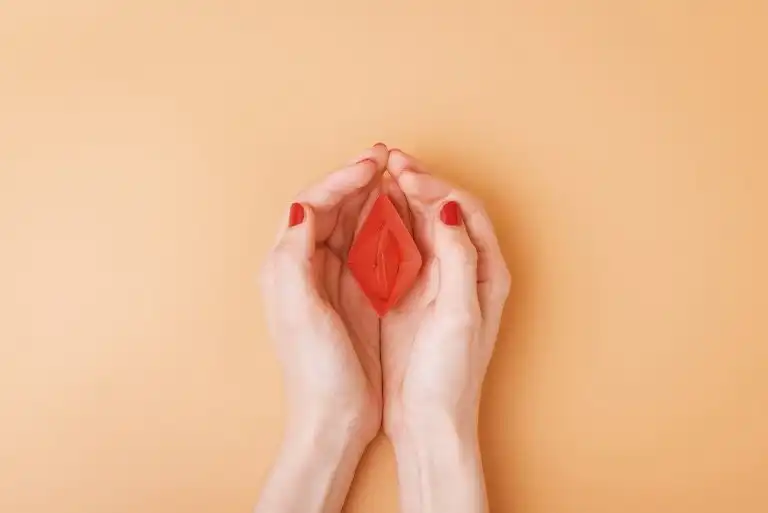
We asked Dr Gandhali Deorukhkar Pillai, Consultant Obstetrics Gynaecologist, Wockhardt Hospitals, South Bombay to reveal everything that one needs to know about losing the v-card. Dr Pillai says, “You should talk to your partner about his history of sexually transmitted diseases or any kind of medication he could be on. After you’ve received an answer to this question from your partner, here are 5 things you need to keep in mind when you’re losing your virginity: 1. You might not orgasm the first time Sex, for the first time, doesn’t guarantee an orgasm. Your goal shouldn’t be that. A study published in the journal Advances in Psychosomatic Medicine Home observed that approximately 11 to 41 per cent of women face difficulty in climaxing with their partner. So, do not get your hopes high but make sure you relax and enjoy the moment. 2. You can get pregnant the first time Have you been thinking that you cannot get pregnant the first time you have sex? That’s far from the truth! If you don’t take any safety precaution, there’s always the risk of getting pregnant. So, ensure you’re aware of the different contraception methods and pick one for your first time.Virginity has countless mythical perceptions. It is time you know the actual reality. Image Courtesy: Shutterstock 3. Know about your fertility cycle Dr Pillai says, “Tracking your menstrual cycle will give you know the dates on which you’re fertile. This will help you avoid any actions that can cause an unwanted pregnancy.” 4. You can get an STI without vaginal penetration Apart from vaginal penetration, STI or sexually transmitted infection can also spread through oral sex or anal penetration. Hence, it is important for your partner to wear a condom all the time and not just during penetration. 5. It might be uncomfortable but it shouldn’t hurt much The first time can be uncomfortable and painful, but it shouldn’t be extremely painful. You can use antibiotic creams for any cuts and bruises after consulting with your doctor. You may experience pain due to the lack of lubrication but if it is extremely painful, it could be because of an underlying medical condition. Hence, if what you experience is debilitating pain, you should probably postpone the maiden act and visit a doctor. “You might have a mild urinary tract infection or urinary burning. But, if you experience foul-smelling discharge or a lot of itching in your private parts, you must talk to your gynaecologist,” advises Dr Pillai. So, girls, make sure you don’t just make your first time memorable but also safe! Source: https://winningbrain.com.ng/5-things-a-gynaecologist-wants-you-to-know-about-losing-your-virginity/
COVID-19 Positive Woman Suffers Memory Loss, Brain Fog
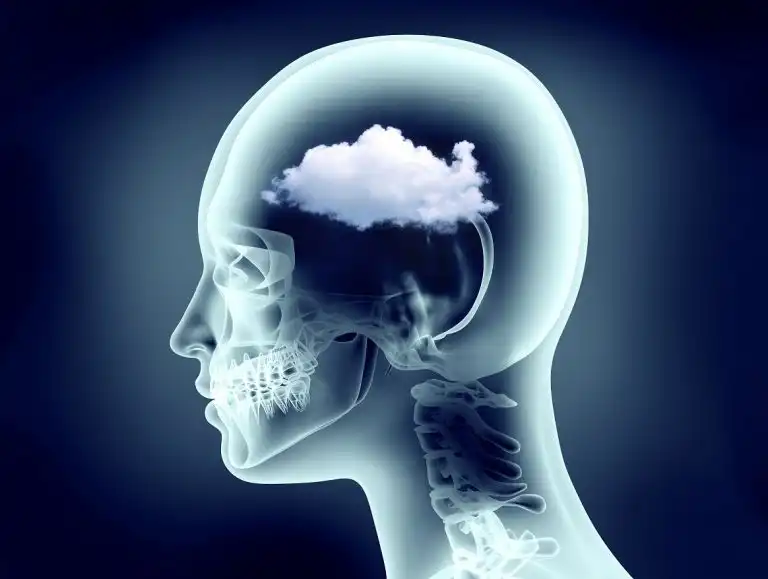
Shaista Pathan, 47, a native of Palghar, is suffering from memory loss and brain fog after testing positive for COVID-19. According to a report in Times Of India (TOI), Pathan was rushed to Mumbai’s Wockhardt Hospital on August 14 after she complained of abdominal pain and headache. When she arrived at the hospital, she was reportedly restless, drifting in and out of consciousness and disturbed. “When she arrived, even five nurses couldn’t calm her down or draw blood. However, the next morning, we noticed neck stiffness that suggested an infection in the central nervous system” neurologist Pavan Pai, was quoted as saying by TOI. On August 19, she was diagnosed with viral encephalitis, an inflammation of the brain, and also tested positive for COVID-19. Now, even after two months, Pathan still has moments of “difficulties”. “My sons tell me not to think hard as I get a headache and a bit of confusion,” said Pathan. “She cannot remember eight days of the infection, but is otherwise healthy,” said neurologist Pavan Pai, who treated her. In the US, news reports stated that patients complained of forgetfulness or brain fog after being diagnosed with COVID-19. Source: https://odishabytes.com/covid-19-positive-woman-suffers-memory-loss-brain-fog/
Anulom Vilom Benefits

The practice of yoga needs no introduction. It has been a way of living for generations, largely for its various health benefits. And there’s nothing that yoga can’t do for you. That’s why it is our go-to solution for anything and everything! One of the practices of yoga—anulom vilom, also known as the alternate nostril breathing is one of the most beneficial breathing exercises. Let’s look at some of its benefits: 1. Boosts the respiratory system A study published in the Journal of Ayurveda and Integrative Medicine found that alternative breathing practices can improve the functioning of the lungs. Further, it strengthens the lungs and improves any respiratory issues, such as asthma or chest infection. 2. Improves digestion Controlled breathing helps in better blood and oxygen flow in the body, which can help you with any stomach-related infections, or even constipation. It also helps to improve the functioning of your digestive system. 3. Reduces stress As we all know any kind of exercise or physical activity helps to reduce the cortisol levels, and this is true in the case of anulom vilom too! Researchers from a study published in the Journal of Indian Medical Association found that participants who performed anulom vilom showed improvement in anxiety levels, as compared to those who practiced suryanamaskar. 4. Minimises snoring Controlled breathing in anulom vilom helps to remove any kind of blockages present in your nostrils and allows smooth and constant passage of oxygen. This ensures that issues such as snoring are subsequently reduced. 5. Maintains a healthy heart Anulom vilom helps in purifying blood with better oxygen supply, and removing any blockages. This, in turn, helps in regulating blood pressure, thereby reducing the risk of any heart disease. What is Anulom Vilom Pranayama? One particular kind of pranayama, or regulated breathing in yoga, is called Anulom Vilom. Also known as alternate nostril breathing, it involves inhaling through any one nostril and exhaling through the other, alternating between them. This rhythmic breath control aims to balance the two hemispheres of the brain, improve focus, and enhance overall well-being. Practitioners believe it cleanses the energy channels, or Nadis, promoting optimal life force circulation. Anulom Vilom is well known for promoting respiratory health, lowering tension, and soothing the psyche. Anulom Vilom breathing is safe and risk-free for most individuals to practice. How is Anulom Vilom Pranayama Performed? When doing Anulom Vilom Pranayama, one should sit comfortably with an upright spine. Follow these steps: Start by doing this for a minute or two. When you do it for the first time, it could feel a little weird, so only do it when you’re comfortable. Source: https://www.healthshots.com/fitness/staying-fit/these-are-the-5-benefits-of-anulom-vilom-that-you-just-cant-ignore/ FAQs on Anulom Vilom Q. How many times should I do Anulom Vilom? You can repeat Anulom Vilom 60 times or for 5 minutes. This may be done at any time of day. Q. What are the immediate effects of Anulom Vilom? Anulom Vilom pranayama provides immediate effects like reduced stress, improved focus, enhanced respiratory function, and a sense of calmness. This alternate nostril breathing helps balance the mind and body. Q. Which organ is exercised by Anulom Vilom? You may strengthen your respiratory system, expand your lung capacity, and enhance the general performance of your respiratory organs by engaging in Anulom Vilom practices. Q. Which time is best for Anulom Vilom pranayam? Any pranayama should be performed between two hours before sunrise and one hour after sunrise. It is also advantageous to do it close to sunset. Q. Is Anulom Vilom good for high BP? Anulom Vilom may be able to significantly reduce blood pressure in those with hypertension, high blood pressure, and cardiac problems brought on by artery constriction.






